Fabrication of ZnO-Al2O3-PTFE Multilayer Nano-Structured Functional Film on Cellulose Insulation Polymer Surface and Its Effect on Moisture Inhibition and Dielectric Properties
Abstract
:1. Introduction
2. Materials and Methods
2.1. Materials and Sample Preparation
2.2. Sample Processing and Characterization Methods
3. Results and Discussions
3.1. SEM/EDS
3.1.1. Surface Topography Analysis
3.1.2. Cross-Section Topography Analysis
3.2. Hydrophobicity and Hygroscopicity Analysis
3.3. Measurement of Oil Immersion Rate
3.4. Frequency Dielectric Properties of the Sputtered Pressboard
3.5. AC Breakdown Performance of Different Samples
4. Conclusions
Author Contributions
Acknowledgments
Conflicts of Interest
References
- Martin, J.H. Basic Material. In J&P Transformer Book, 13th ed.; Newnes: Amsterdam, The Netherlands, 2007; pp. 59–74. [Google Scholar]
- CIGRE Joint Working Group A2/B4.28. HVDC Converter Transformers Design Review, Test Procedures, Ageing Evaluation and Reliability in Service. In Proceedings of the 43th Conference International des Grands Reseaux Electriques (CIGRE 2010), Paris, France, 23–27 August 2010. [Google Scholar]
- CIGRE Joint Working Group A2/B4.28. HVDC Converter Transformers Guide Lines for Conducting Design Reviews for HVDC Converter Transformers. In Proceedings of the 43th Conference International des Grands Reseaux Electriques (CIGRE 2010), Paris, France, 23–27 August 2010. [Google Scholar]
- Liu, J.; Fan, X.; Zheng, H.; Zhang, Y.; Zhang, C.; Lai, B.; Wang, J.; Ren, G.; Zhang, E. Aging Condition Assessment of Transformer Oil-Immersed Cellulosic Insulation Based upon the Average Activation Energy Method. Cellulose 2019, 26, 3891–3908. [Google Scholar] [CrossRef]
- Liao, R.; Yang, L.; Zheng, H.; Wang, K.; Ma, Z. Reviews on Oil-Paper Insulation Thermal Aging in Power Transformers. Trans. China Electrotech. Soc. 2012, 27, 1–12. [Google Scholar]
- Emsley, A.M.; Stevens, G.C. Review of Chemical Indicators of Degradation of Cellulosic Electrical Paper Insulation in Oil-Filled Transformers. IEE Proc. Sci. Meas. Technol. 1994, 141, 324–334. [Google Scholar] [CrossRef]
- Oommen, T.V.; Prevost, T.A. Cellulose Insulation in Oil-Filled Power Transformers: Part II Maintaining Insulation Integrity and Life. IEEE Electr. Insul. Mag. 2006, 22, 5–14. [Google Scholar] [CrossRef]
- Du, Y.; Zahn, M.; Lesieutre, B.C.; Mamishev, A.V.; Lindgren, S.R. Moisture Equilibrium in Transformer Paper-Oil Systems. IEEE Electr. Insul. Mag. 1999, 15, 11–20. [Google Scholar] [CrossRef]
- Hohlein, I.; Kachler, A.J. Aging of Cellulose at Transformer Service Temperatures. Part 2. Influence of Moisture and Temperature on Degree of Polymerization and Formation of Furanic Compounds in Free-Breathing Systems. IEEE Electr. Insul. Mag. 2005, 21, 20–24. [Google Scholar] [CrossRef]
- Belén, G.; Burgos, J.C.; Alonso, A.M.; Sanz, J. A Moisture-in-Oil Model for Power Transformer Monitoring—Part II: Experimental verification. IEEE Trans. Power Deliv. 2005, 20, 1423–1429. [Google Scholar]
- Hao, J.; Chen, G.; Liao, R.; Yang, L.; Tang, C. Influence of Moisture on Space Charge Dynamics in Multilayer Oil-Paper Insulation. IEEE Trans. Dielectr. Electr. Insul. 2012, 19, 1456–1464. [Google Scholar] [CrossRef]
- Prevost, T.A. Thermally Upgraded Insulation in Transformers. In Proceedings of the Electrical Insulation Conference & Electrical Manufacturing Expo 2005, Indiannapolis, IN, USA, 23–26 October 2005. [Google Scholar]
- Qin, T.F. Study on Mechanism of Wood Surface Non-Polarization Part III. The Difference of Esterification Ability of Wood Main Composites. China Wood Ind. 2000, 14, 13–15. [Google Scholar]
- Emsley, A.M.; Stevens, G.C. Kinetics and Mechanisms of the Low-Temperature Degradation of Cellulose. Cellulose 1994, 1, 26–56. [Google Scholar] [CrossRef]
- Liao, R.; Wu, W.; Nie, S.; Liu, T.; Zhang, S. Study on the Synergistic Anti-Aging Effect of Composite Thermal Stabilizers on the Insulation Paper by Molecular Modeling. Trans. China Electrotech. Soc. 2015, 30, 330–337. [Google Scholar]
- Liang, N.; Liao, R.; Min, X.; Yang, M.; Yuan, Y. Influence of Amine Compounds on the Thermal Stability of Paper-Oil Insulation. Polymers 2018, 10, 891. [Google Scholar] [CrossRef] [PubMed]
- Liao, R.; Zhang, F.; Yang, L. Electrical and Thermal Properties of Kraft Paper Reinforced with Montmorillonite. J. Appl. Polym. Sci. 2012, 126, 291–296. [Google Scholar] [CrossRef]
- Yuan, Y.; Liao, R. A Novel Nano-Modified Cellulose Insulation Paper for Power Transformer. J. Nanomater. 2014, 17, 1–6. [Google Scholar] [CrossRef]
- Liao, R.; Lv, C.; Yang, L.; Zhang, Y.; Wu, W.; Tang, C. The Insulation Properties of Oil-Impregnated Insulation Paper Reinforced with Nano-TiO2. J. Nanomater. 2013, 2013, 1. [Google Scholar] [CrossRef]
- Zhang, F.; Liao, R.; Yuan, Y.; Li, Y.; Peng, Q.; Liu, T. Preparation for Low-Permittivity Insulation Paper and Its Breakdown Performance. High. Volt. Eng. 2012, 38, 691–696. [Google Scholar]
- Liaor, R.; Liu, H.; Bai, G.; Hao, J.; Li, X.; Lin, Y. Space Charge Characteristics and Dielectric Properties of Nano-SiO2/Aramid Paper Composite. Trans. China Electrotech. Soc. 2016, 31, 40–48. [Google Scholar]
- Takahashi, K.; Yoshikawa, A.; Sandhu, A. Crystal Growth. In Wide Bandgap Semiconductors, Fundamental Properties and Modern Photonic and Electronic Devices, 1st ed.; Springer: Berlin, Germany, 2007; pp. 329–433. [Google Scholar]
- Gupta, T.K.; Carlson, W.G. A Grain-Boundary Defect Model for Instability/Stability of a ZnO Varistor. J. Mater. Sci. 1985, 20, 3487–3500. [Google Scholar] [CrossRef]
- Ellmer, K.; Klein, A.; Rech, B. Electrical Properties. In Transparent Conductive Zinc Oxid; Springer: Berlin, Germany, 2008; pp. 35–79. [Google Scholar]
- Wang, X.; Cheng, X.; Chen, S.Q.; Zheng, X.Q.; Tu, D.M. Dielectric Properties of the Composites of Nano-ZnO/Low-Density Polyethylene. Proc. CSEE 2008, 19, 13–19. [Google Scholar]
- Cheng, Y.; Bai, L.; Yu, G.; Zhang, X. Effect of Particles Size on Dielectric Properties of Nano-ZnO/LDPE Composites. Materials 2019, 12, 5. [Google Scholar] [CrossRef] [PubMed]
- Yan, S.; Liao, R.; Yang, L.; Zhao, X.; He, L. Influence of nano-Al2O3 on Electrical Properties of Insulation Paper under Thermal Aging. In Proceedings of the 2016 IEEE International Conference on High Voltage Engineering and Application (ICHVE 2016), Chengdu, China, 19–22 September 2016; pp. 1–4. [Google Scholar]
- Bobzin, K.; Lugscheider, E.; Maes, M.; Piñero, C. Relation of Hardness and Oxygen Flow of Al2O3 Coatings Deposited by Reactive Bipolar Pulsed Magnetron Sputtering. Thin Solid Films 2006, 494, 255–262. [Google Scholar] [CrossRef]
- Beysens, D.; Chatain, D.; Evesque, P.; Garrabos, Y. Synthesis of α-Al2O3 Thin Films Using Reactive High-Power Impulse Magnetron Sputtering. Europhys. Lett. 2006, 3, 36002–36005. [Google Scholar]
- Liu, H.; Chi, M.; Chen, Q.; Gao, Z.; Wei, X. Analysis of Dielectric Characteristics of Nano-Al2O3 Modified Insulation Pressboard. Proc. CSEE 2017, 37, 4246–4253. [Google Scholar]
- Hao, J.; Li, Y.; Liao, R.; Liu, G.; Liao, Q.; Tang, C. Fabrication of Al2O3 Nano-Structure Functional Film on a Cellulose Insulation Polymer Surface and Its Space Charge Suppression Effect. Polymers 2017, 9, 502. [Google Scholar] [CrossRef] [PubMed]
- Yong, J.; Fang, Y.; Chen, F.; Huo, J.; Yang, Q.; Hao, B.; Du, G.; Hou, X. Femtosecond Laser Ablated Durable Superhydrophobic PTFE Films with Micro-through-Holes for Oil/Water Separation: Separating Oil from Water and Corrosive Solutions. Appl. Surf. Sci. 2016, 389, 1148–1155. [Google Scholar] [CrossRef]
- Hou, W.; Wang, Q. Stable Polytetrafluoroethylene Superhydrophobic Surface with Lotus-Leaf Structure. J. Colloid Interface Sci. 2009, 333, 400–403. [Google Scholar] [CrossRef]
- Wan, Y.; Yu, Y.; Cao, L.; Zhang, M.; Gao, J.; Qi, C. Corrosion and Tribological Performance of PTFE-Coated Electroless Nickel Boron Coatings. Surf. Coat. Technol. 2016, 307, 316–323. [Google Scholar] [CrossRef]
- Hao, J.; Liu, C.; Li, Y.; Liao, R.; Liao, Q.; Tang, C. Preparation Nano-Structure Polytetrafluoroethylene (PTFE) Functional Film on the Cellulose Insulation Polymer and Its Effect on the Breakdown Voltage and Hydrophobicity Properties. Materials 2018, 11, 851. [Google Scholar] [CrossRef]
- Zuo, Z.; Liao, R.; Zhao, X.; Song, X.; Qiao, Z.; Guo, C.; Zhuang, A.; Yuan, Y. Anti-Frosting Performance of Superhydrophobic Surface with ZnO Nanorods. Appl. Therm. Eng. 2017, 110, 39–48. [Google Scholar] [CrossRef]
- Jonscher, A.K. Dielectric Relaxation in Solids. J. Phys. D Appl. Phys. 1999, 32, 57–70. [Google Scholar] [CrossRef]
- Frimpong, G.; Fuhr, J. Modelling of Dielectric Measurements on Power Transformers. In Proceedings of the 37th Conference International des Grands Reseaux Electriques (CIGRE 1998), Paris, France, 1–5 September 1998. [Google Scholar]
- Cheng, Y. Investigation on Morphology and Dielectric Properties of Micro, Nano-ZnO/LDPE Composites. Ph.D. Thesis, Harbin University of Science and Technology, Harbin, China, 2017. [Google Scholar]
- Cheng, P.; Li, S.; Zhang, L.; Li, J. Characterization of Intrinsic Donor Defects in ZnO Ceramics by Dielectric Spectroscopy. Appl. Phys. Lett. 2008, 93, 988. [Google Scholar] [CrossRef]
- Weibull, W.; Rockey, K.C. Presentation of Results. In Fatigue Testing and Analysis of Results, 1st ed.; Pergamon Press: Oxford, UK, 1961; pp. 159–166. [Google Scholar]
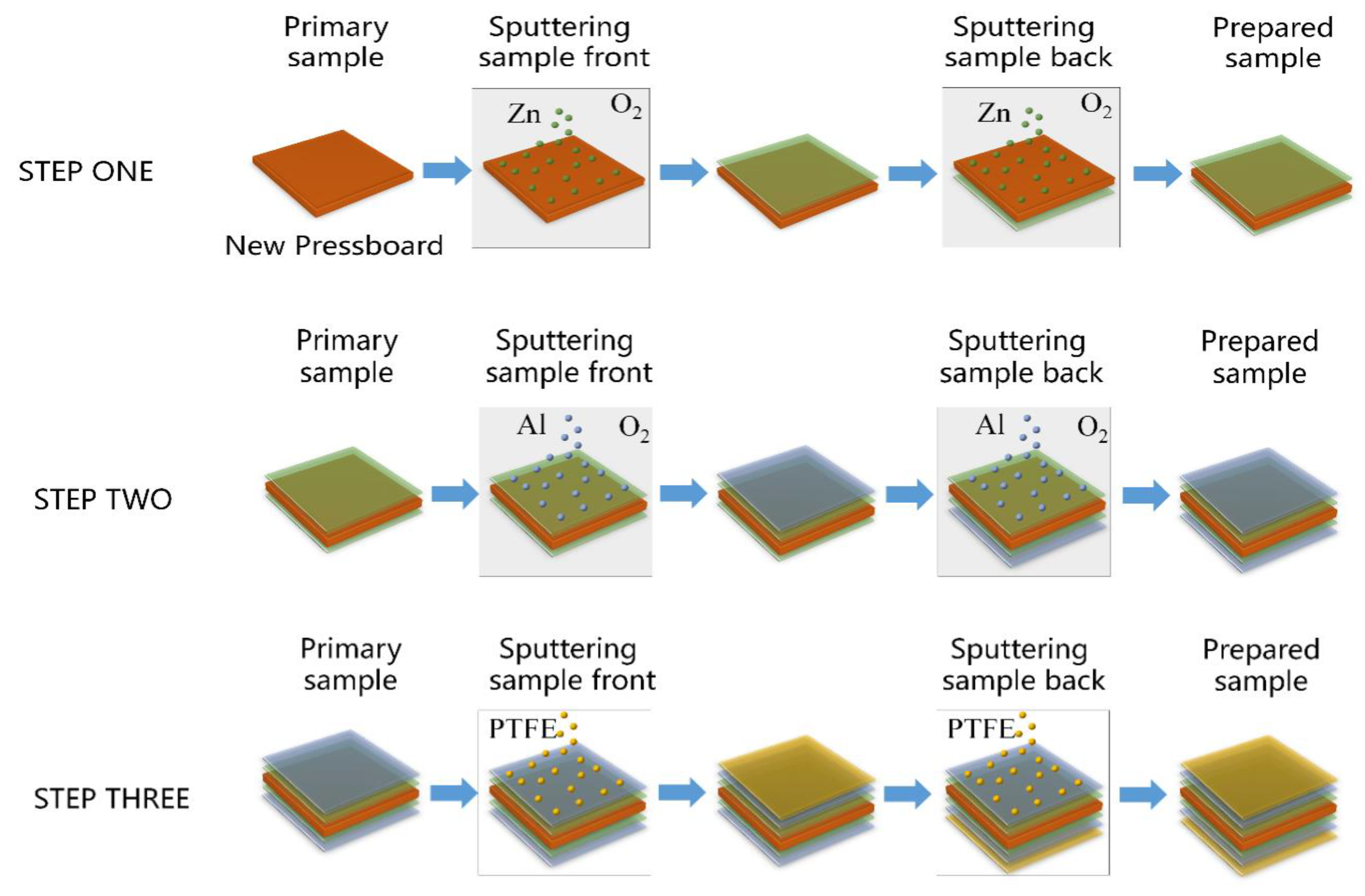
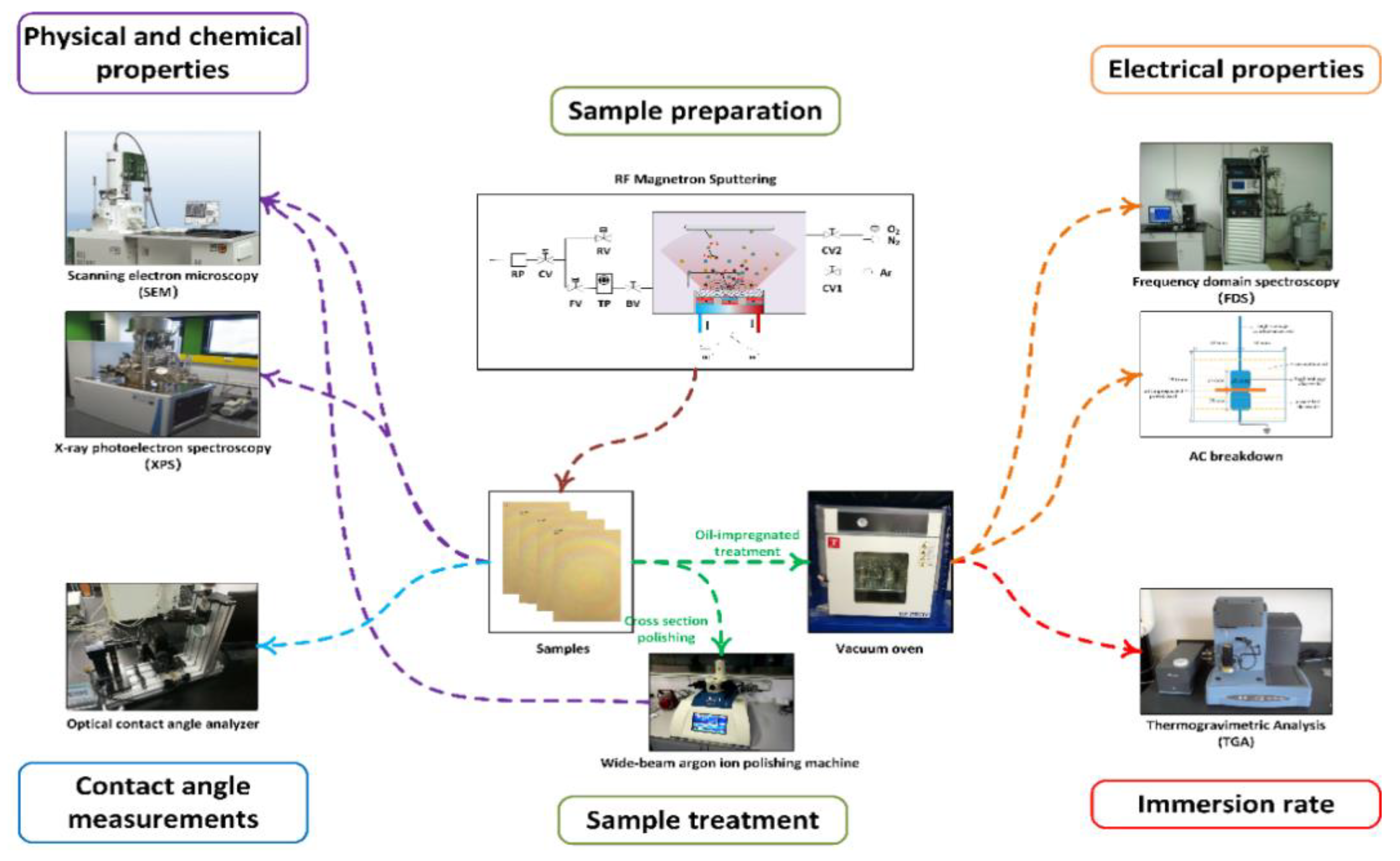
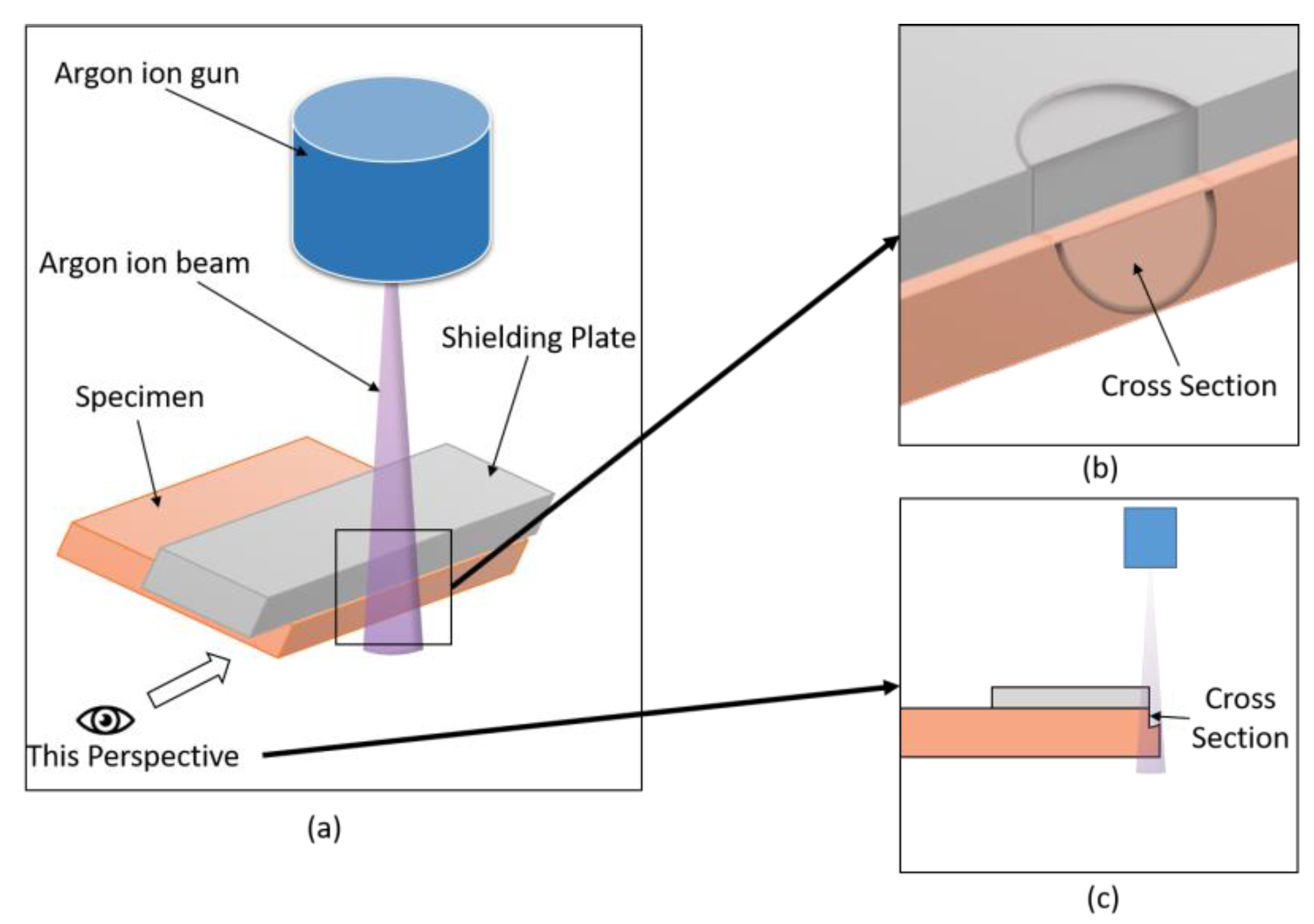
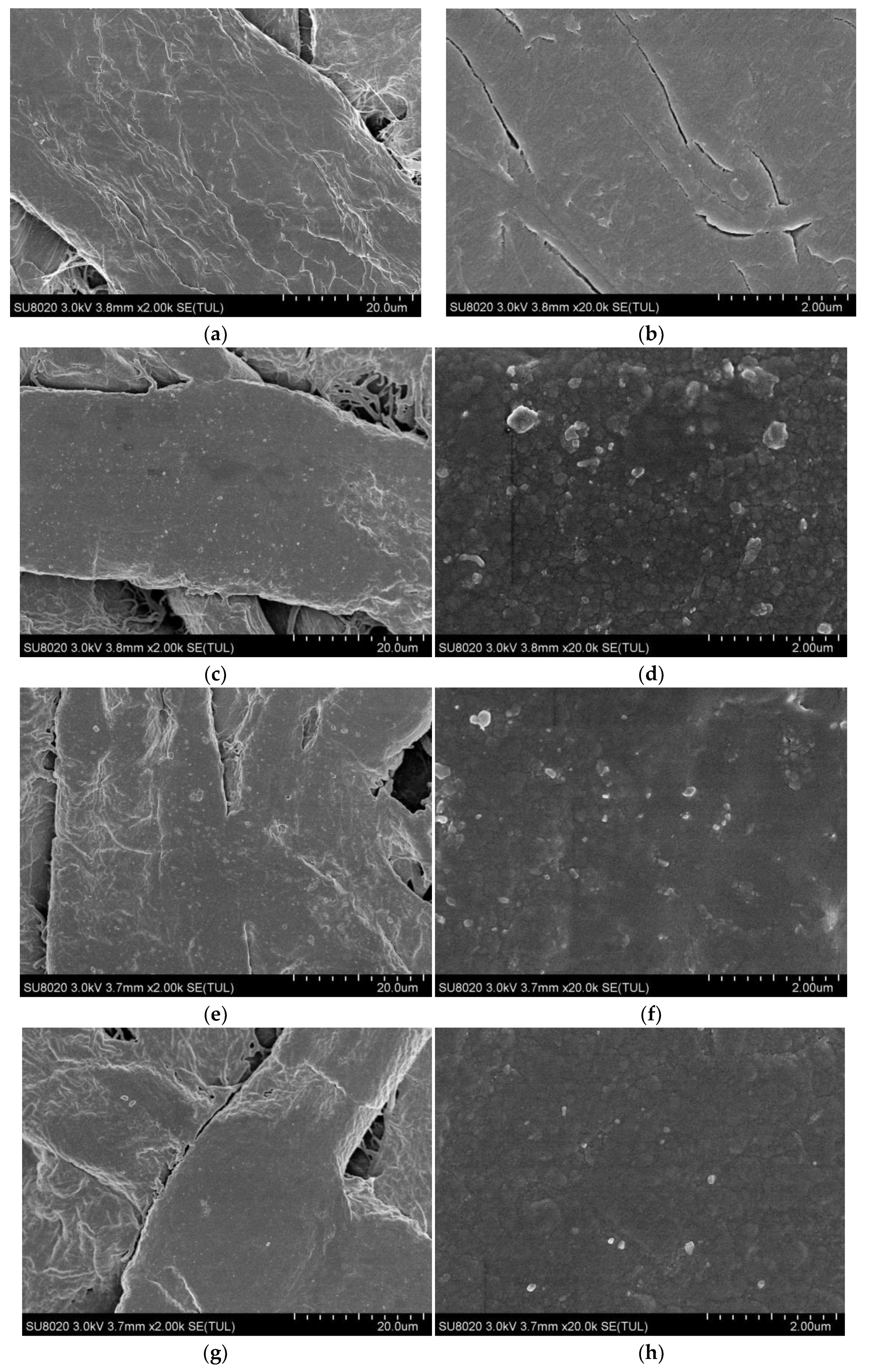



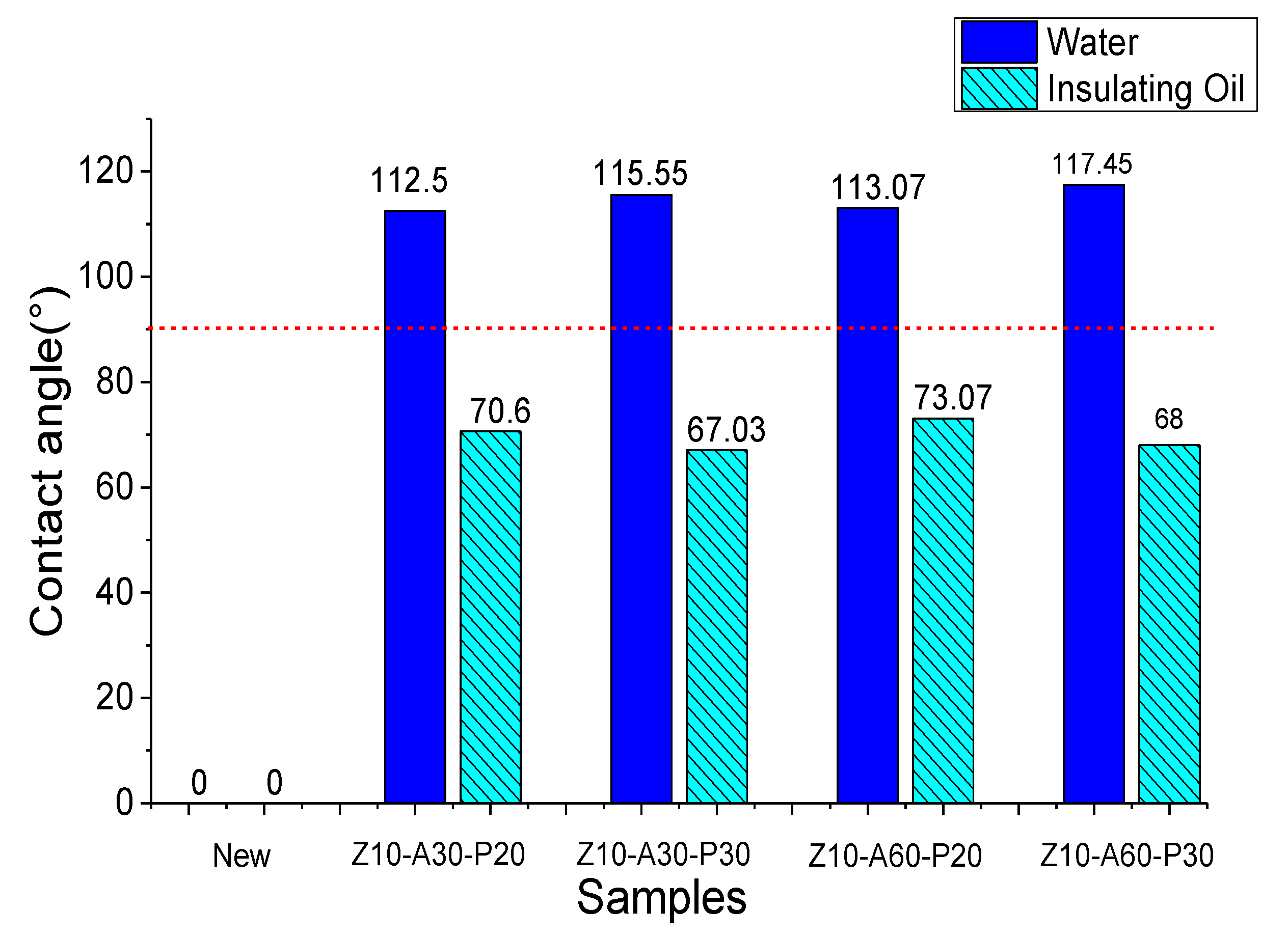


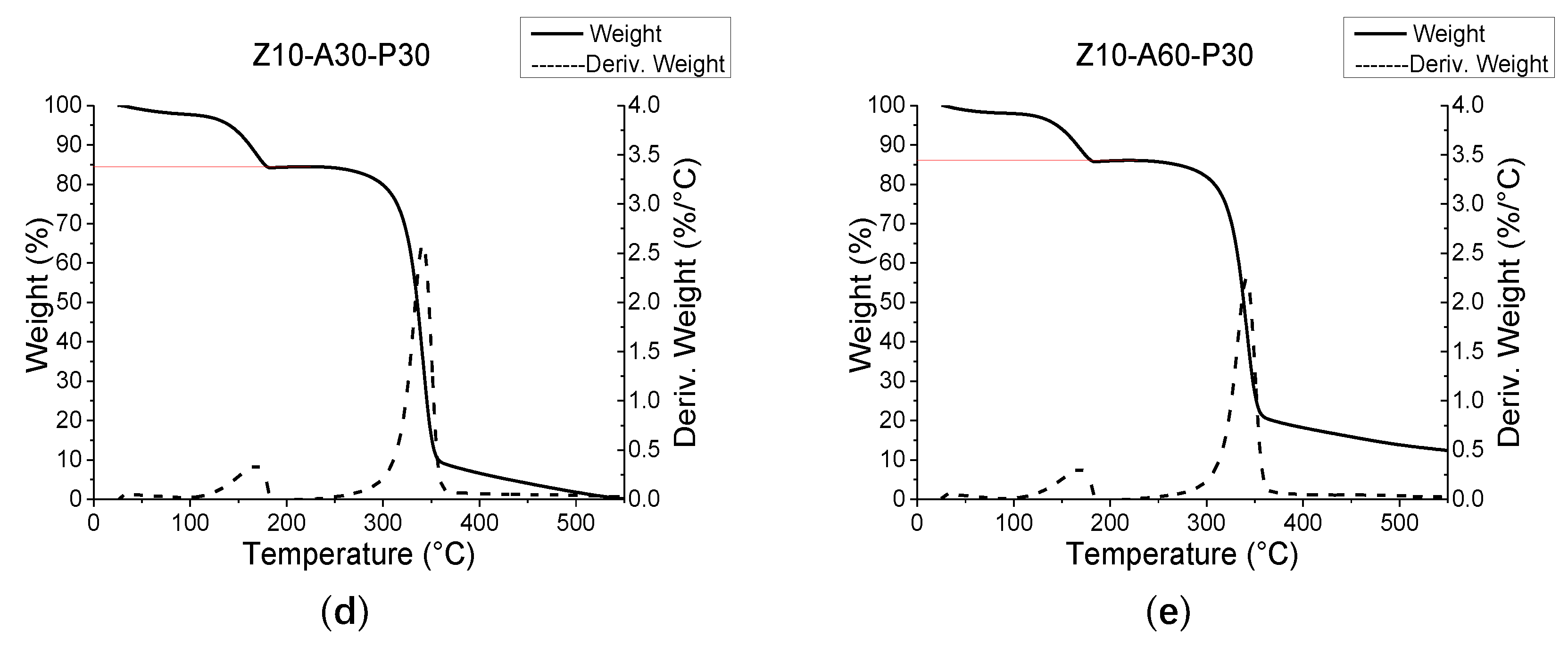
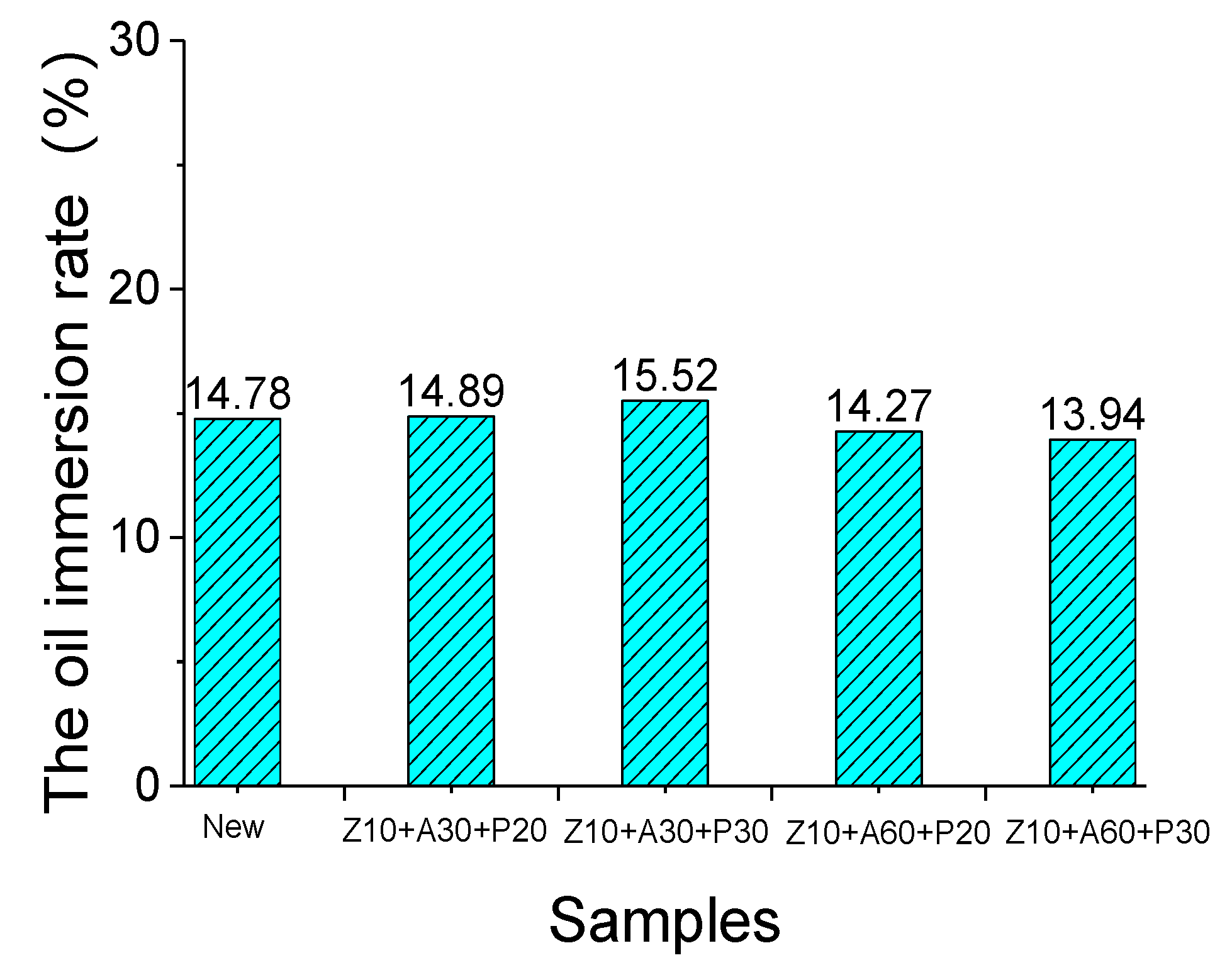
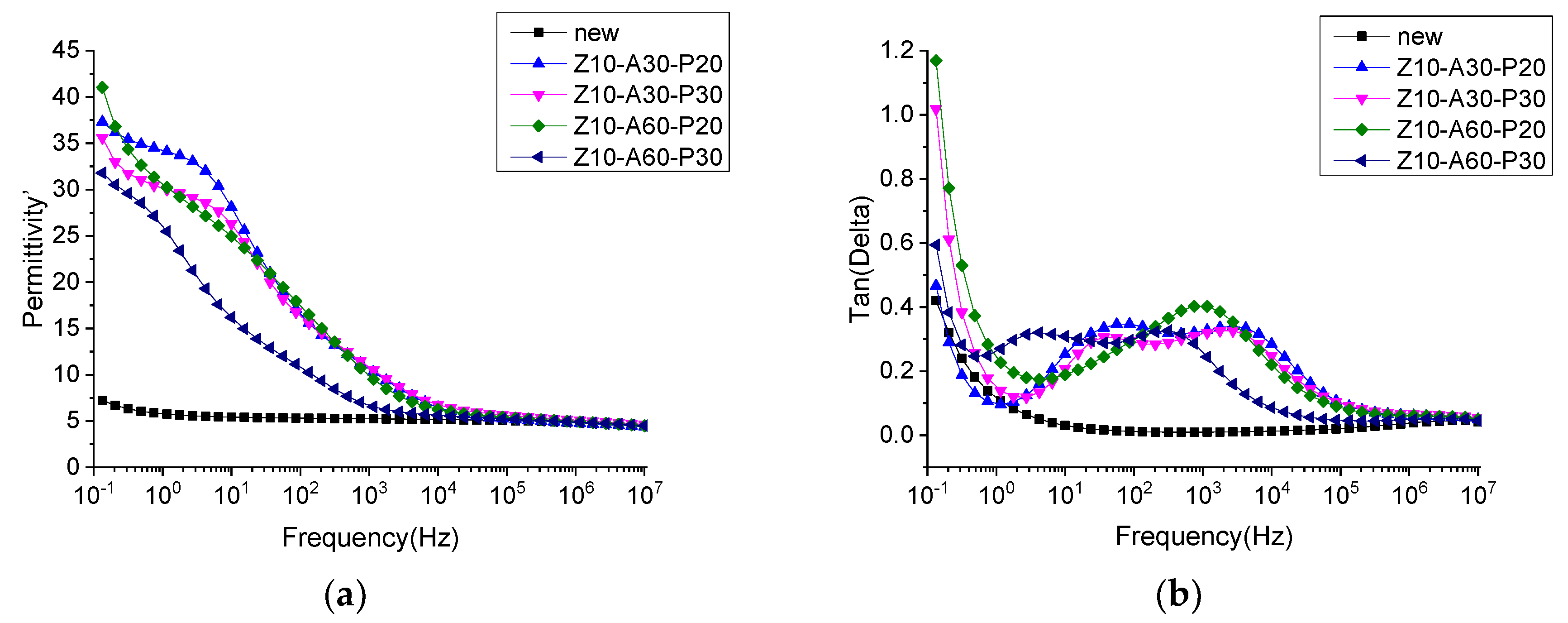


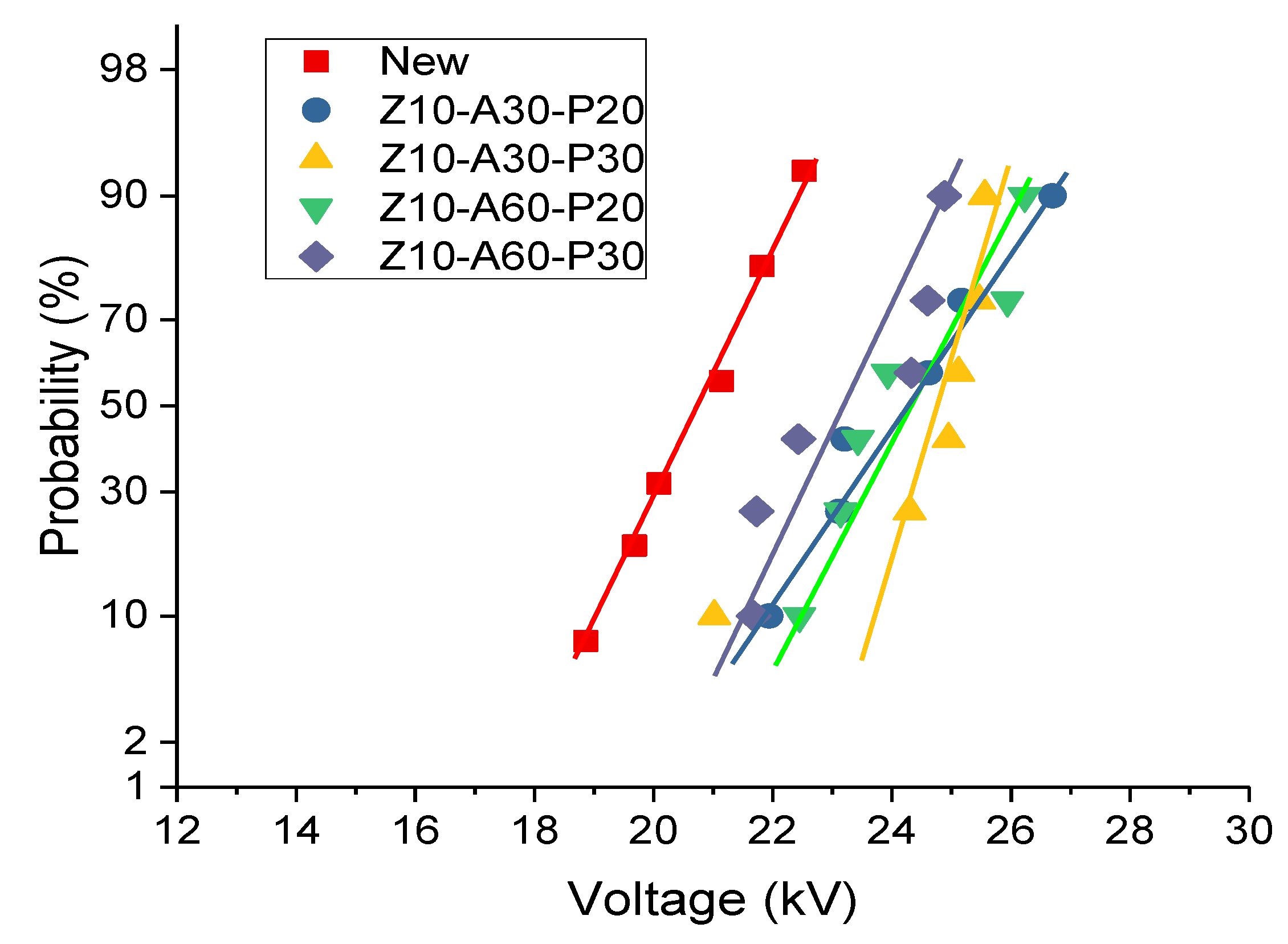
| Sample Name | Time for Sputtering ZnO | Time for Sputtering Al2O3 | Time for Sputtering PTFE |
|---|---|---|---|
| New | 0 | 0 | 0 |
| Z10-A30-P20 | 10 min | 30 min | 20 min |
| Z10-A30-P30 | 10 min | 30 min | 30 min |
| Z10-A60-P20 | 10 min | 60 min | 20 min |
| Z10-A60-P30 | 10 min | 60 min | 30 min |
| Test Number | AC Breakdown Voltage (kV) | ||||
|---|---|---|---|---|---|
| Untreated Pressboard | Z10-A30-P20 | Z10-A30-P30 | Z10-A60-P20 | Z10-A60-P30 | |
| 1 | 19.68 | 24.62 | 24.3 | 23.14 | 24.88 |
| 2 | 20.09 | 23.21 | 24.95 | 23.93 | 21.68 |
| 3 | 22.53 | 21.94 | 21.02 | 22.45 | 24.6 |
| 4 | 18.86 | 25.17 | 25.12 | 26.23 | 22.43 |
| 5 | 21.14 | 23.12 | 25.47 | 23.43 | 21.73 |
| 6 | 21.82 | 26.7 | 25.56 | 25.94 | 24.33 |
| Sample | (kV/mm) | |
|---|---|---|
| New | 42.569 | 18.410 |
| Z10-A30-P20 | 49.748 | 16.368 |
| Z10-A30-P30 | 50.018 | 27.463 |
| Z10-A60-P20 | 49.754 | 18.106 |
| Z10-A60-P30 | 47.828 | 20.479 |
© 2019 by the authors. Licensee MDPI, Basel, Switzerland. This article is an open access article distributed under the terms and conditions of the Creative Commons Attribution (CC BY) license (http://creativecommons.org/licenses/by/4.0/).
Share and Cite
Liu, C.; Hao, J.; Li, Y.; Liao, R. Fabrication of ZnO-Al2O3-PTFE Multilayer Nano-Structured Functional Film on Cellulose Insulation Polymer Surface and Its Effect on Moisture Inhibition and Dielectric Properties. Polymers 2019, 11, 1367. https://doi.org/10.3390/polym11081367
Liu C, Hao J, Li Y, Liao R. Fabrication of ZnO-Al2O3-PTFE Multilayer Nano-Structured Functional Film on Cellulose Insulation Polymer Surface and Its Effect on Moisture Inhibition and Dielectric Properties. Polymers. 2019; 11(8):1367. https://doi.org/10.3390/polym11081367
Chicago/Turabian StyleLiu, Cong, Jian Hao, Yanqing Li, and Ruijin Liao. 2019. "Fabrication of ZnO-Al2O3-PTFE Multilayer Nano-Structured Functional Film on Cellulose Insulation Polymer Surface and Its Effect on Moisture Inhibition and Dielectric Properties" Polymers 11, no. 8: 1367. https://doi.org/10.3390/polym11081367
APA StyleLiu, C., Hao, J., Li, Y., & Liao, R. (2019). Fabrication of ZnO-Al2O3-PTFE Multilayer Nano-Structured Functional Film on Cellulose Insulation Polymer Surface and Its Effect on Moisture Inhibition and Dielectric Properties. Polymers, 11(8), 1367. https://doi.org/10.3390/polym11081367





